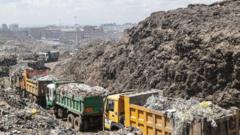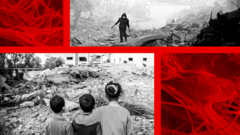A community-driven initiative aims to monitor methane levels in urban spaces, utilizing handheld sensors and advanced satellites to tackle the health risks associated with air pollution. Despite growing detection methods, translating data into effective action remains a challenge as methane emissions continue to rise.
The Challenge of Methane Detection: A Crucial Task for a Healthier Future

The Challenge of Methane Detection: A Crucial Task for a Healthier Future
As methane emissions rise, volunteers and advanced technology unite to tackle the challenge of detection amidst health risks and environmental implications.
In and around Washington, D.C., a coalition of volunteers and environmental activists has embarked on a grassroots mission to assess air quality, particularly focusing on methane presence. Equipped with specialized handheld monitors resembling walkie-talkies, these volunteers measure various gases, particularly methane, which poses substantial health risks and environmental challenges.
Recent tests conducted by these community researchers revealed concerning figures: during a 25-hour period, they identified 13 outdoor methane leaks with concentrations surpassing the lower explosive limit, alongside notable leaks within homes. This alarming discovery has raised significant health concerns, as methane exposure and associated gases, like nitrogen oxide from gas stoves, correlate with an uptick in asthma prevalence, particularly among children. Djamila Bah, a healthcare worker involved in the effort, noted a staggering statistic: in homes tested by the community organization Action in Montgomery, one out of three children suffers from asthma.
Methane's dual threat lies not only in its danger to human health but also in its role as a potent greenhouse gas. While methane has a shorter atmospheric lifespan than carbon dioxide, it traps heat far more efficiently, contributing to approximately 25% of the global temperature rise since the onset of industrialization. Methane emissions originate from varied sources, including fossil fuels, waste management, and agricultural activities.
Detecting this elusive gas can be achieved through various techniques. The handheld devices used for monitoring, complemented by infrared cameras, convert methane from an invisible substance to a measurable entity. Monitoring strategies can employ ground-based apparatus, such as vehicles, or aerial dynamics, including drones. However, as Andreea Calcan from the International Methane Emissions Observatory points out, a definitive solution is challenging due to budgetary constraints and the scale of analysis required across multiple facilities. Fortunately, advancements in affordable methane sensors over the past decade provide optimism for widespread monitoring capabilities.
On a broader scale, satellite technology has emerged as a powerful tool in identifying large methane emissions. Innovations like the Tanager-1 satellite, developed by the Carbon Mapper organization in collaboration with NASA and Planet Labs, aim to enhance detection capabilities from space. While traditional satellites may struggle to capture emissions in challenging environments, Tanager-1 boasts improved resolution that can effectively differentiate emissions from oil wells and pipelines, addressing accountability issues in major emitting sectors.
The Tanager-1 satellite commenced operational data release in November 2024, marking a significant step forward in methane analysis. The MethaneSAT project, initiated by the Environmental Defense Fund, similarly aims to enhance monitoring capabilities. As these sophisticated technologies proliferate, Riley Duren, CEO of Carbon Mapper, emphasizes that what was once invisible is now becoming clear, revealing the full scope of society's methane footprint.
Despite advancements in detection technology, translating this knowledge into meaningful action remains complex. Instances of energy companies employing enclosure combustors to obscure methane flaring emphasize challenges in accountability. The Methane Alert and Response System (MARS), which utilizes satellite data to identify emissions and alert operators and governmental agencies, faces limitations as only a small percentage of alerts result in responsive action. Nevertheless, the MARS team remains hopeful that increased awareness will lead to more proactive measures in the future.
Community involvement, particularly by individuals in areas like Washington, D.C., has proven impactful, empowering residents to take readings themselves and combat misinformation regarding air quality. As Joelle Novey of Interfaith Power and Light articulated, understanding the issues better positions society to enact positive changes.






















